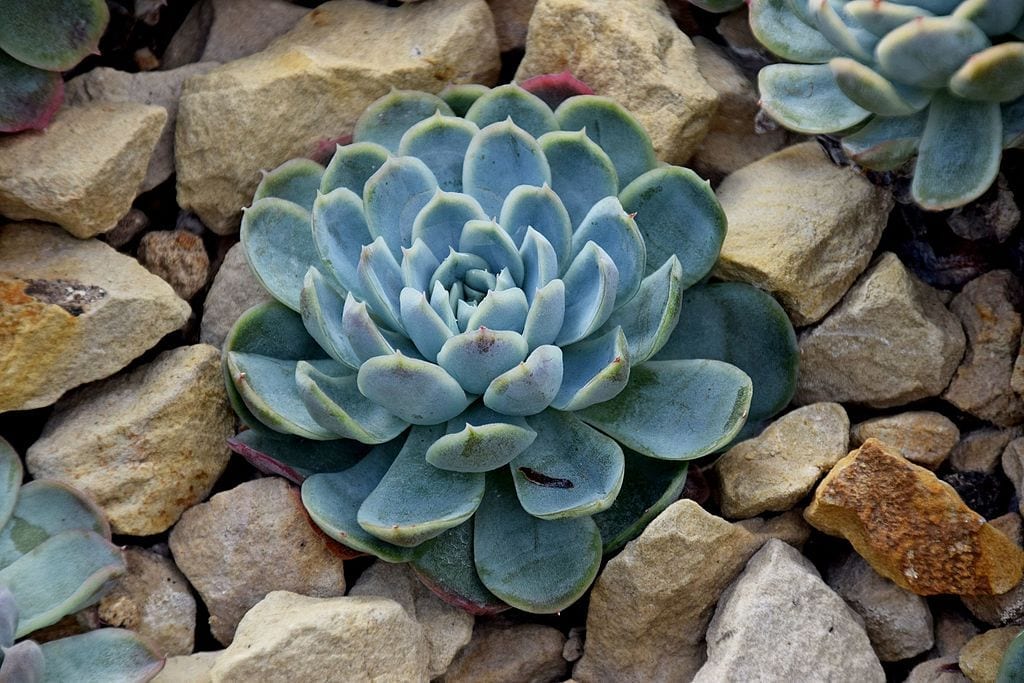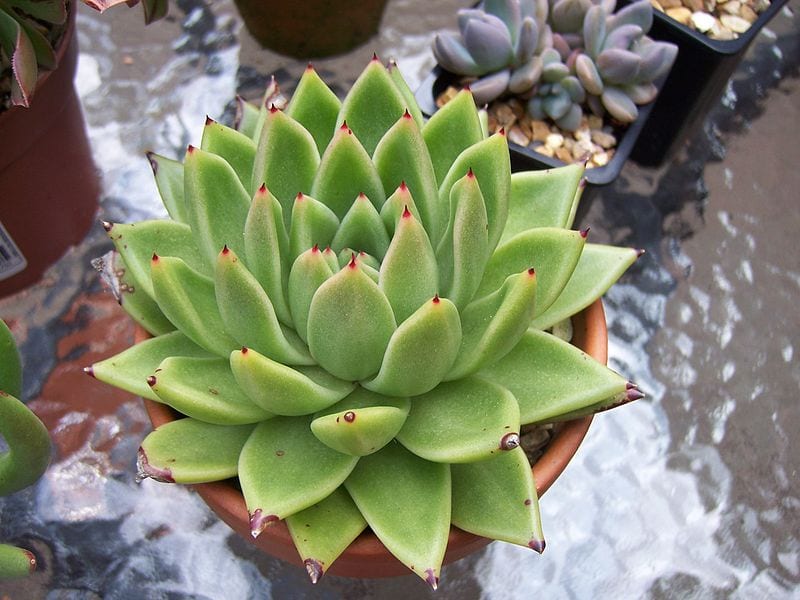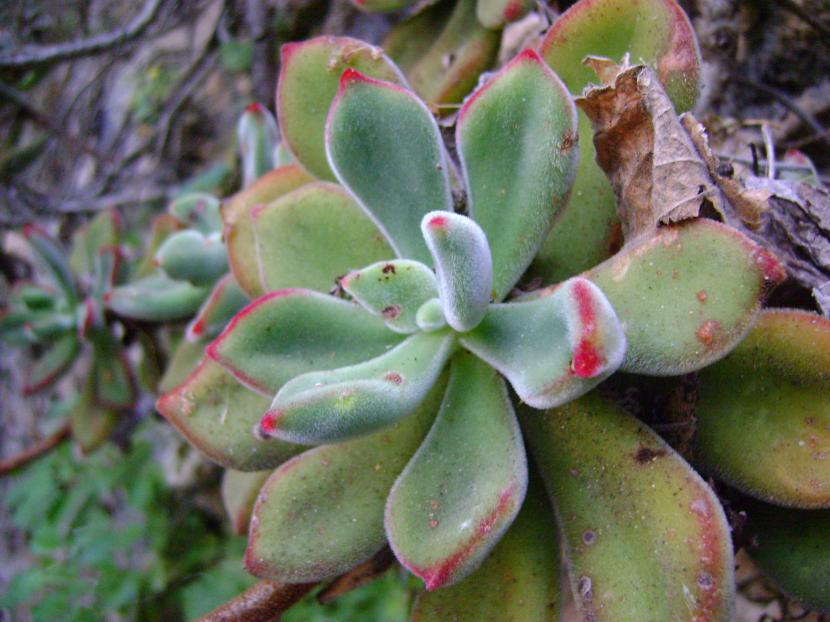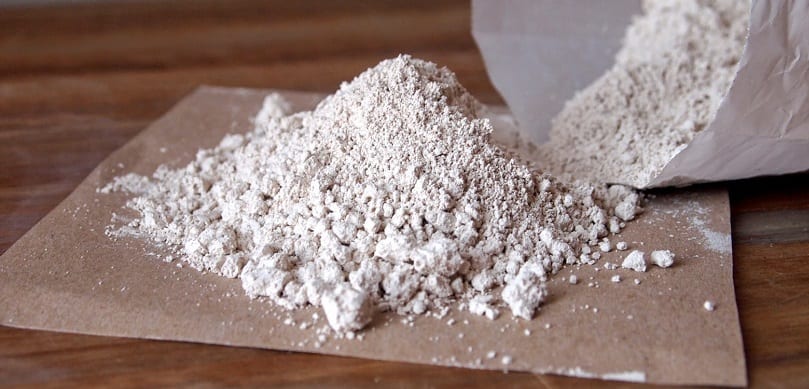
Echeveria runyonii 'Topsy turvy' // Image - Wikimedia / Forest & Kim Starr
Succulents like the ones that I am going to present you next are wonderful, because although they already produce very beautiful petals, they themselves seem to be, also, artificial flowers or plants made by a professional. The most interesting thing is that there are many types of Echeveria, each one more decorative and curious.
I'm not going to lie to you: they are not exactly the easiest succulents to care for, but they are not complicated either. If you want to start your collection, or expand it, now you are going to see various types and in the end, I will tell you how to keep them in good condition.
7 types of Echeveria for garden or pot
echeveria elegans

Image - Wikimedia / Krzysztof Golik
Known as alabaster rose, it is a plant native to Mexico that forms rosettes of thick pale blue leaves. The flowers are grouped in clusters 10-15cm long, and are pink.

Echeveria agavoides

Image - Flickr / 唐 喬
It is originally from Mexico, and forms a rosette of fleshy leaves, more or less triangular, green with red tips. It produces a floral stem about 50cm long, with pink, orange or red flowers.

echeveria lilac

It is native to Mexico, and forms a rosette of ovate and very compact leaves of bluish-gray, deep green or pinkish green. The flowers sprout from a flower stalk and are pink or red.
Echeveria glauca (now Echeveria secunda)

Image - Wikimedia / Vengolis
It is an endemic plant of Mexico, where it is known as conchita or tememetla. Form a compact rosette of leaves, about 20cm in diameter, fleshy and glaucous. The flowers sprout from a flower stalk that can be up to 31cm long, and are reddish or pinkish.
Echeveria silky

Image - Wikimedia / Cody Hough
It is a native plant of the mountains of the state of Puebla (Mexico). Develops a rosette of fleshy, green leaves up to 15cm tall covered by whitish villi. It produces red and yellow flowers on a thin and long stem, about 30cm.
Echeveria pulvinata

Image - Flickr / loverdar
Known as echeveria peluda, it is a plant native to Oaxaca (Mexico) that develops a rosette of oval leaves covered by white hairs. The flowers are grouped in clusters and are red or orange.

Echeveria imbricata (hybrid of Echeveria secunda 'Glauca' and Echeveria gibbiflora 'Metalica')

Image - Flickr / mcgrayjr
It is a hybrid plant that produces a rosette of oval green, pinkish-green, or bluish-green leaves. The flowers come out of a short stem, about 10-20cm, and are yellow or pink.
How to take care of the Echeveria?
If you want to have one, or if you already have and doubts about its care, we recommend you follow these tips:
Location
- Body exterior:: Ideally, they should be in full sun, or at least in a very bright area. But be careful not to expose it to the star king without first accustoming it, since otherwise its leaves would burn quickly.
- Interior: needs a lot of light. If you have windows in a room that overlook a clear area outside, place it there, close (never right in front, as it could also burn).
Earth

Image - Wikimedia / Salicna
- Flower pot: fill it with sandy substrates, such as the cheekbones (for sale here) or the akadama (for sale here). Another option is to mix universal growing medium (for sale here) with perlite (for sale here) in equal parts.
- Garden: it needs a land that is capable of draining water quickly, as its roots are very sensitive to waterlogging. As this soil is difficult to have in a garden, what is done a lot is to dig a hole deep and wide enough to be able to later introduce a block (of those that are square, about 20x20cm minimum, and are hollow), and then fill it that block with some substrate that we mentioned before. In order not to run any risk, before laying the substrate you can introduce a piece of shading mesh so that the roots are never in contact with the original soil of your garden.
Irrigation
escaso. During the summer, it will be necessary to water something more often, but always try to leave the substrate between waterings. In case of having it in a pot, never wet its leaves and, if you put a plate under it, remember to remove any excess water 30 minutes after watering.
Subscriber
From early spring to late summer It is important to fertilize the Echeveria with a liquid fertilizer for cacti and succulents (for sale here) or in granules (for sale here) following the instructions specified on the package.
Multiplication

Echeveria polishedis // Image - Flickr / Rüveyde
Although they can be multiplied by seeds, this method is quite complicated. It is necessary to place a seedbed with a sandy substrate that will always be kept slightly humid, near a heat source, and to do treatments with fungicide to avoid fungi. And yet, no matter how much control you have, you cannot be sure that they will germinate.
Therefore, what is done is to multiply it by leaf or stem cuttings in spring-summer. The way to proceed in any case is the same:
- A leaf or stem is separated from the plant.
- Let it dry for a couple of days (up to a week if it is a stem).
- And it is planted in pots with universal growing substrate mixed with perlite in equal parts.
In the case of the leaves, they lie down, covering a little the narrowest part (the one that kept it attached to the mother plant). Thus, you will begin to see that they prosper more or less after 15 days.
Planting or transplanting time
En spring. If it is potted, transplant every 2 years or so.
Plagues and diseases
They are very resistant, but mealybugs, aphids (in the flowers especially) and the molluscs (snails and slugs) are enemies that must be watched and controlled, for example with diatomaceous earth (for sale here).

Rusticity
The Echeveria resist the cold, but the frosts harm them. It is preferable that it does not drop below 0 degrees, but if in your area there are weak and occasional frosts of up to -2ºC you will not have to worry too much. Its leaves may well suffer some frost damage, but nothing serious.
Of course, there are some species, such as E. ruyonii, which is better to protect indoors. If you have questions, contact us.

echeveria laui // Image - Wikimedia / Salicna
What do you think of these plants?
I have really liked all the varieties of echeveria that I have discovered on this page, they are beautiful and I would like to start a collection of them.
Hello isbael.
The truth is that yes, they are very beautiful plants.
You can get them in nurseries and garden stores 🙂
Greetings.
Hello, I have an echeveria glauca in a pot and the leaves below are drying up ... Why can that be? What do I do? Thanks for your help!
Hello Pailina.
It is normal to lose the leaves below. Do not worry.
Of course, it is important that the soil dries completely before watering it again, since it does not resist excess water. For this same reason, it should not be planted in a pot without holes, or put a plate under it.
Greetings.
narvaezantonia56@gmail.com
The councils are very good, thank you, actually, it already happened to me, some Echeverría leaves fell off.
The rain fell on them
Hola!
If the rain is very strong it can drop the leaves of the echeverias, although if it is loose it should not, unless the plant is weak. In the first case, it is not serious; but in the second one, it would be necessary to see if it receives the amount of light it needs and if it is watering properly.
Greetings.
Thanks for the information I have learned new things to be able to take care of them. idana_r@live.com.mx
Thank you very much Idalia for reading us. Greetings!